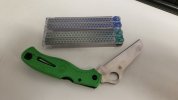For fairly inexpensive USB scopes I would recommend immediately ditching use of the built in ring light. If on a budget, use a nice bright light source like a good spot LED flashlight, preferably with a choice of brightness levels and put it in some kind of holder so you can repeatably and precisely position it. To start, set your blade up such that the bevel is as close to parallel to the scope lens as possible, and adjust from there. Keep the light at an oblique angle such that the flashlight is pointed almost directly at and inline with the apex (so that if it were say, instead of light, a bullet shot out of a gun, it would hit with a barely glancing blow). Try keeping that angle and moving the light source around to different places but still pointing directly at the blade. Try changing the distance from the light source to the blade, as well as varying the brightness. Try raising and lowering the light. Do the same with the angle of your blade. Eventually you will find the happy spot for good informative imaging. This will be an individual thing in terms of exact placement for every scope and light source, and maybe even every blade.
There are additional tricks that can be used like placing a piece of white or black paper below your subject, or adjacent such that light bounces off and hits your subject, etc. Try them all, experiment. Different techniques will work better for different information - for instance, one technique might work better for viewing the scratch pattern, and another better for trying to view the apex only.
I liked the Celestron scope I had, it was decent and had a 5 MP camera, which isn't terrible. This image (Chosera 1k bevel set burr) from the microscope thread was taken with it.

There are additional tricks that can be used like placing a piece of white or black paper below your subject, or adjacent such that light bounces off and hits your subject, etc. Try them all, experiment. Different techniques will work better for different information - for instance, one technique might work better for viewing the scratch pattern, and another better for trying to view the apex only.
I liked the Celestron scope I had, it was decent and had a 5 MP camera, which isn't terrible. This image (Chosera 1k bevel set burr) from the microscope thread was taken with it.

Last edited:

